More Low-down on Workbenches
After 55 years of manual working my back still holds strong and that is from standing work at a workbench six days a week for 8-10 hours moist days throughout my life. My neck feels just fine and comfortable too, quite as good as ever. If suddenly something went wrong I could hardly complain after so many good years. Short term working at a workbench is unlikely to do much more to you than cause less comfort than you’d like, long term is different, and by that I mean it’s important for you to establish the optimum height as early on as you can. I’ve written more on this over the years on my blog. Use the search box. That works too.
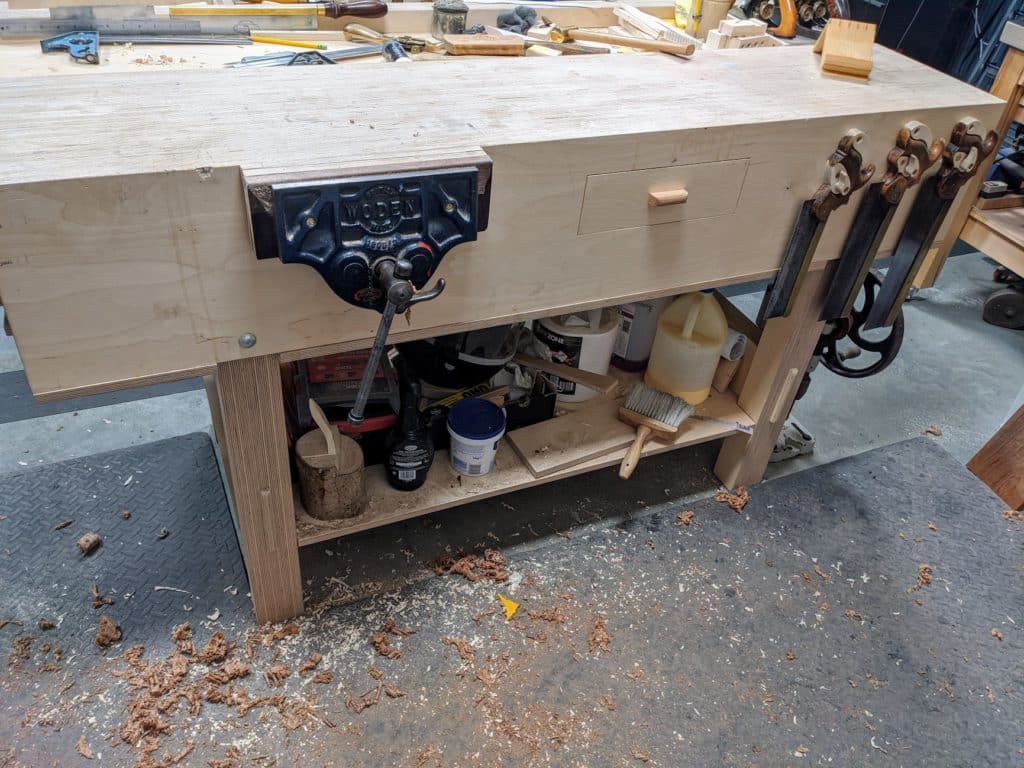
You can’t ask a machine-only woodworker or one who occasionally allows a little plane work or chisel chopping here and there for any kind of knowing advice unless they did have a background of substantial handwork using hand tools to work with. It’s more likely that they are primarily working in more an assembly mode most of the time. Low benches work great for routing and Skilsaw work, jigsaws and such, and then too, especially, parts assembly, belt sanding and so on. In fact, I suspect that that is where bench heights mostly come from these days. For hand toolists though, the rigours of full-on planing, sawing, mortise chopping and then and only then the assembly of components place very different demands on the user. For our work, we must often wrestle, push, sideways twist, shove and pull with great force in ways that machinists never need to and we can do that for long periods in a day. Take the efforts of flattening a five-foot plank of rough-sawn mesquite or oak to twist-free levels and smoothness. Now that’s a serious business engaging a mass of upper body effort from braced leg positioning.
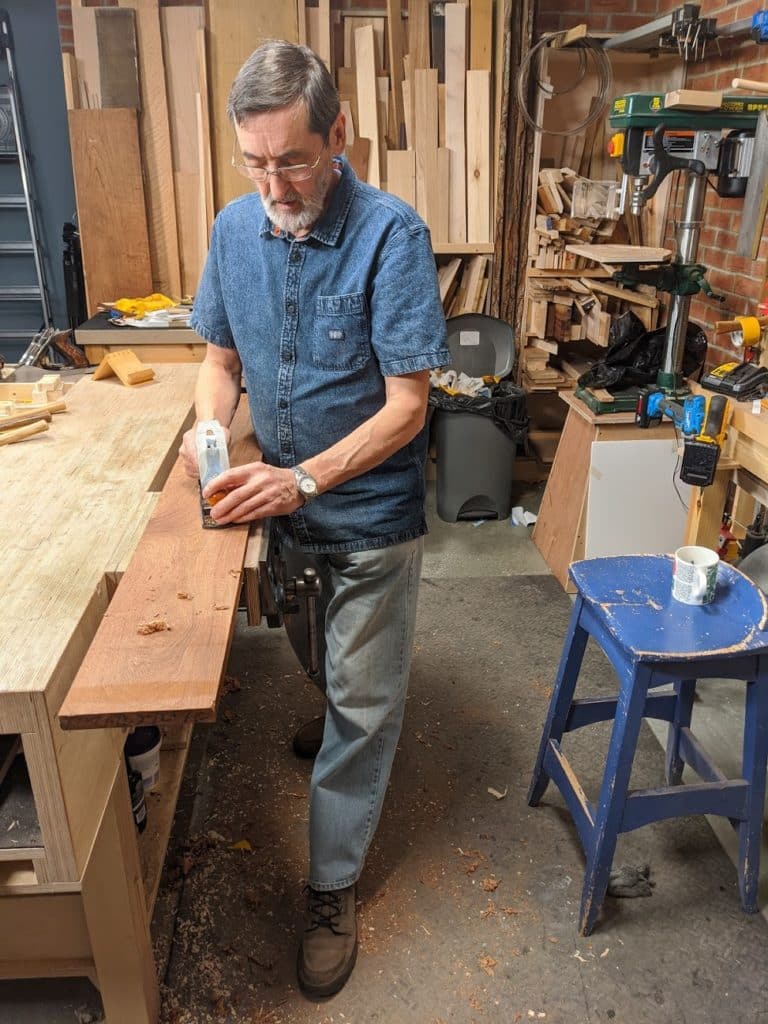
I have written aplenty on the absolute essentiality of establishing good bench work heights for general hand tool working, joiners and furniture makers working primarily with hand tools. It is critical to your long term wellbeing even if you only work for a few hours a week. Indeed we have made enquiries of our audiences through the years and the results of our survey questions have at least helped us to reconsider the difference between low bench heights and those more customised to the height of the person using it; people who once experienced back and neck pain from benchwork said raising their benches by often inches suddenly felt more refreshed and comfortable in their work even after extended periods at the bench when prior to that they had to give up after even a short time.
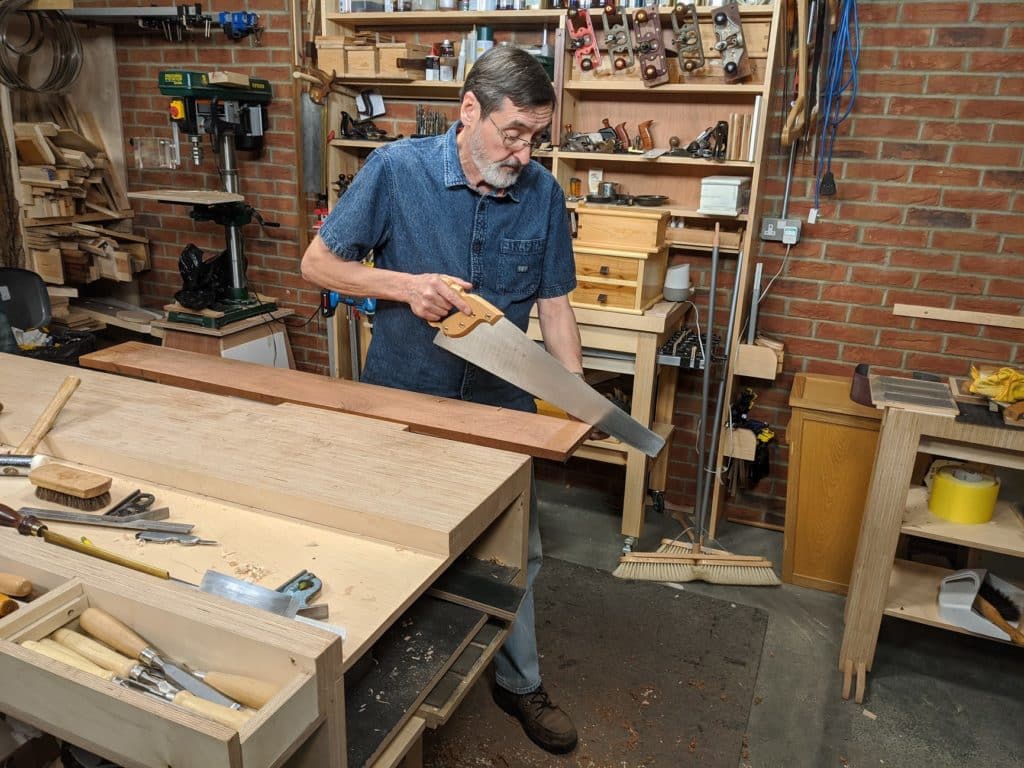
Left and right-handed dedication of workbenches are important too. If you are right-hand dominant, then the tools you reach for will be either directly in front of you or to your right. So too, if you are left-handed then the tools will mostly be the opposite as will be the placement of the vise and it is mostly this that then determines where you indeed install the vise in the first place.
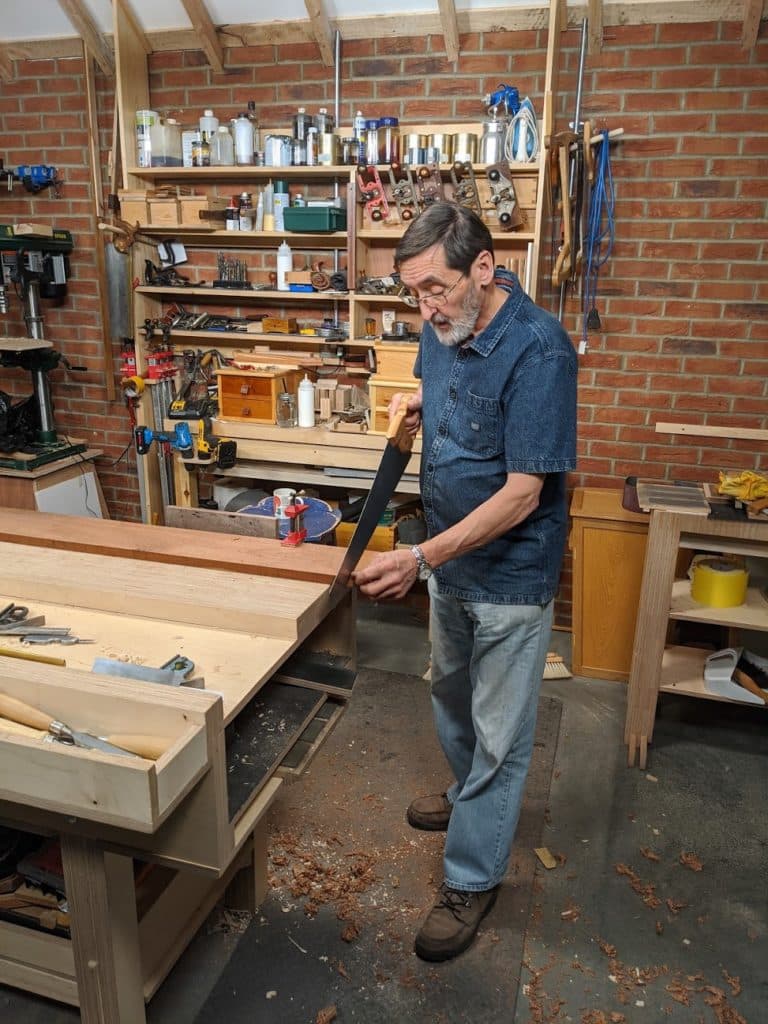
On a workbench, you might ask, ‘Why not just put the vise in the middle?‘ There are a couple of reasons. One, putting the vise centred will usually mean that one side of the benchtop will remain empty while the other side builds up with tools, wood and related day to day equipment. It’s just natural. You use something for a while and lift it away with your dominant hand and place it to that side. Two, clamp anything to the benchtop to work it and your body biases determine work placement. Mostly this is determined by your handedness in terms of dominance.
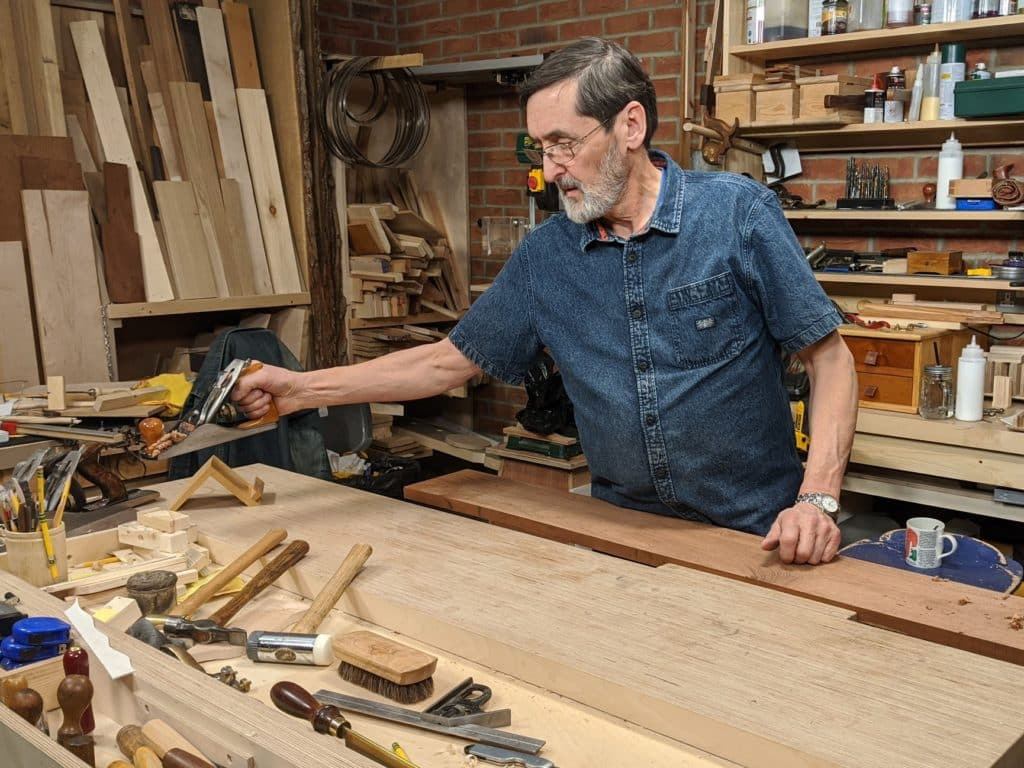
Most people are right or left hand dominant it’s true but, very rarely, some are truly ambidextrous (1% or less) and as such can use either hand equally and that means equally well or equally badly. Then there are those who are two-handed. They can switch from one hand to the other.
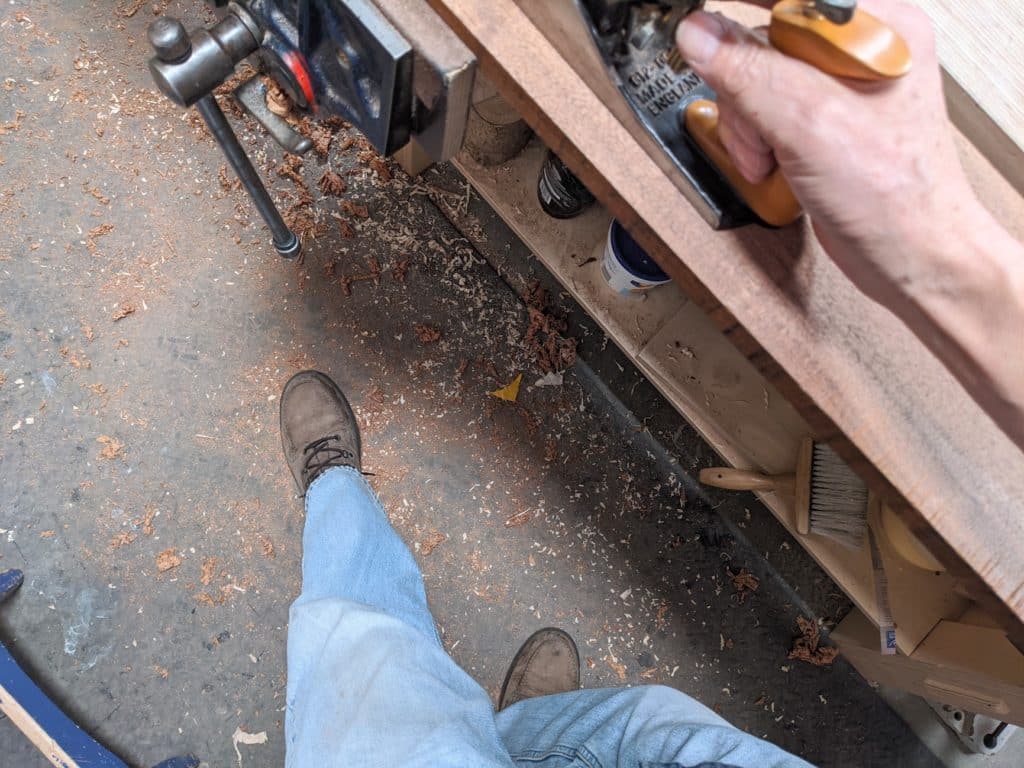
In the case of left-handedness, most left-handers are forced to work their nondominant hand to their benefit purely because tools might not be made for them, available to them at the time, or they are handed a pair of scissors or a can opener designed for right-handed use. In my case, I switch from hand to hand when using some of my tools, not all of them. In my case, I have trained myself to use my left hand say to use a knife for instance, but this is not ambidexterity. I cannot comfortably use my left hand with a chisel hammer and chisel.
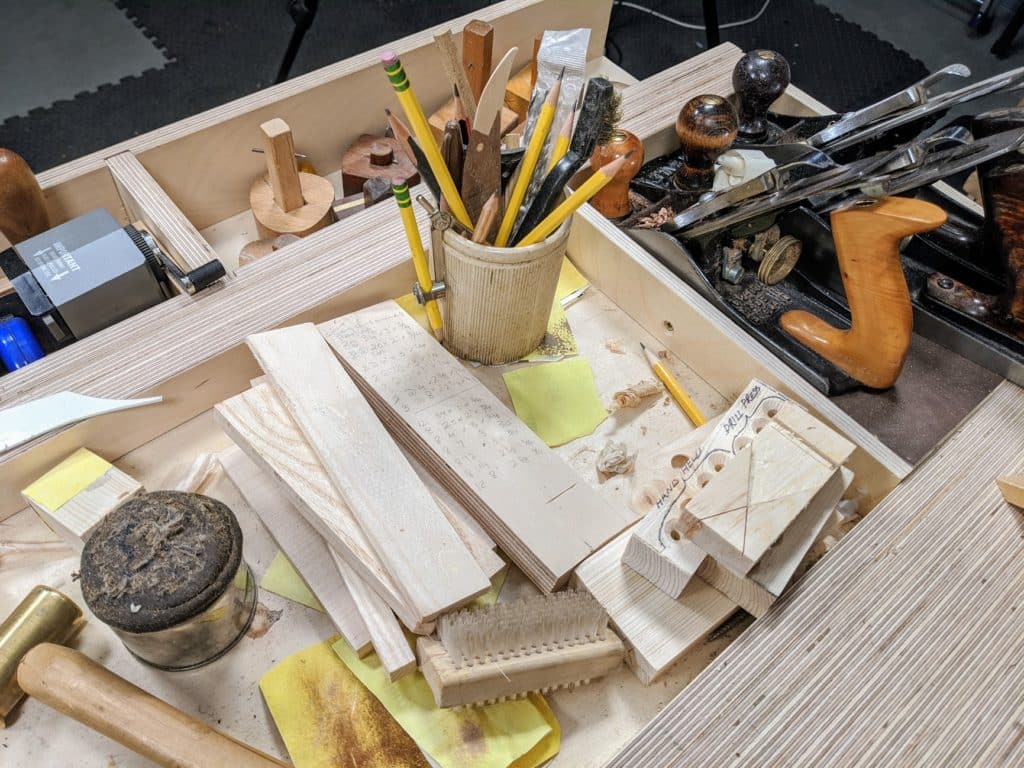
So we see that it is our human form with its individuality, be that body training in and at work, other influential exercising, abilities and disabilities, compensations we make and then our handedness that determines where and how we work at the bench.
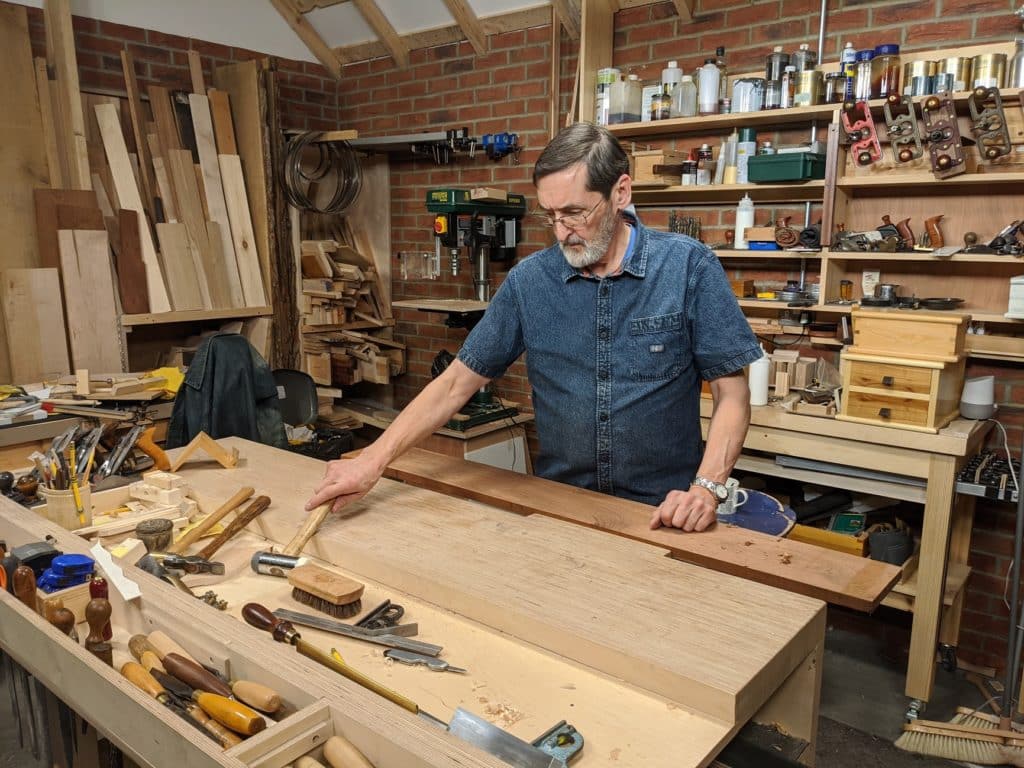
Add into the equation that a disability, no matter how small or minorly limiting, plays a major part in establishing patterns of work and then to the placement of tools and wood to maximise our individual comfort and access to all things surrounding the bench. When I have been the guest demonstrator at the workshops of others or belonging to organisations the workbenches have without exception ALWAYS been 4-6″ too low. Checking on a recognised workbench making company that has made workbenches for a century, I found that they offer adult joiner’s workbenches at 33″ high. This for me would be a back-breaker and so too I believe for 95% of the western world yet you would expect them to offer various heights and a method for establishing the best height in workbenches. for their customers


Paul, I couldn’t agree more. Most workbench plans I see out there are for around 32 inches of height (~81 cm). Way too low. I’m 5 foot 11 or 180 cm tall and my bench is around 41 inches high (104 cm). My assembly table (2 by 4 feet) is 32 inches high and perfect for staging, finishing and gluing, but I can’t plane on it.
Precisely…really we all need a workbench and a separate assembly table. Most shops I’m in don’t accommodate the two.
Our survey has shown that over 90% of people work in a space somewhere around 10 x 10 feet. Put a 2 x 5-foot bench in there and an assembly table suddenly becomes quite the luxury. I have rarely if ever found that my workbench doesn’t accommodate all of my needs but I do need to put things away first.
In case others came here wondering what height is generally recommended, I may be able to save you a search:
“In general, students between 5’4 and 5’11” seem very comfortable at the 38″ height and rarely do we need to make any adjustments.”
(https://paulsellers.com/2013/06/jury-still-out-on-bench-heights/)
“Does this mean there’s a one size fits all? No, not really, just that you should start tall, try it for a few hours and then cut to height incrementally to match the bench to the person. If the bench is a multi-person use bench, then 38” fits the average person but may not work for shorter people.”
(https://paulsellers.com/2013/05/the-question-of-bench-heights/)
“This student […] was 6’2 and liked using the 42″ bench alongside a fellow student who was 6’4″. Both seemed very comfortable.”
(https://paulsellers.com/2013/05/the-question-of-bench-heights/)
Brick, so good of you to be so helpful for everyone, thank you.
Paul you are so right. When I am working at my bench my back doesn’t bother me at all. I practice your lessons in my projects. I’m 67 now but still able to plane and layout.
Thanks for this.
I’m building my bench now and am starting at 42″ and will cut down incrementally. How much of an increment do you recommend? 1″?
I am 5’11”
Instead of cutting down, I suggest you might build up. Adda layer of 3/4″ plywood or other to the floor area right in front of your vise and work on it for a while. Add more until you feel the most comfortable. Before you make that final cut, consider adding a half-inch or so and work at that, just to make sure. Then you can make the cuts confidently.
Some years ago (2013?), I searched what would have been recommended by health and safety agencies (why reinvent the wheel?), what was the average man height at the same time and which body characteristic would be the same.
I guess now health agencies would say that a workbench has to be customised to each individual worker.
But at the time, the average man would be around 5’6″; the lower limit for light work would be 38″ (ok for joinery – note that for heavy work the recommended height was lower and for precision work [clock] the height was higher).
38″ would correspond more or less to t the addition of the anterior superior iliac spine height + the shoe heel height.
This point is on the pelvic bone and is somewhat related to the height one’s back is articulated to the pelvic bone. So in my opinion it makes sense (although I am not a doctor).
Google pictures of “anterior superior iliac spine” to know where it is and compare with your body while wearing your work shoes.
One will of course note that planing a thick board with a wooden plane while wearing slippers is not the same experience as planing a thin board with a metal plane while wearing shoes with 3 cm heals.
Sylvain
What’s the small stump use for on the left side of the lower shelf, I am assuming for axe/hatchet work?
Good catch on the stump! Looking at the workshop details is one of my favorite pastimes on this blog. I really enjoy seeing the purpose-made shop appliances and what looks like the chaos that develops from the creative process. Of course, with Paul it never turns out to be chaos unlike my workbench.
Good lord, look at those holders for the backsaws in the first picture. Pride and care in the smallest details!
I’ve made some for my saws, but it comparison to Paul’s you would think a small child made mine. I’ll have to have another go at it.
There’s a video or a blog post where he’s showing how to make these saw holders with a sort of locking or latching mechanism. A quick search on YouTube or this blog should turn it up for you.
i do auto body, my 1 boss is 90, so there is a vast aray of purpose built and modified tools and jigs all over the shop, they just don’t make commercially available stuff for a lot of what we do, so as a result, unless i just can’t make something, or it’s just too, too much to do so , instead of going to home depot , i try to make a tool out of existing stuff laying around, as a result i have a virtual scrap yard full of dismantled stuff, my girl calls me the “SCAVENGING ANGEL”
When I got started with hand tools I had a lot of back pain using my old workbench even for short periods of time. When I made my new one I made it higher and I’ve realized I can spend hours working at it and not experience any pain.
I do like Jim Tolpin’s Youtube video on sizing workbenches using your hand span. Although, he does recommend a shorter height, he also employs multiple benches at different heights for different operations.
I am not sure the arm length is invariably linked to the torso length, so I have doubts that any reference to any part of the hand is a good reference for the articulation of the back.
Sylvain
just in case:
https://www.albireo.ch/imperialconverter/
Judging by the photos, I’d say that the top of the bench is about in line with the top of Paul’s hip bone. I’d guess that the best way of selecting personal bench height would be to work around the same setting for onesself
“One, putting the vise centred will usually mean that one side of the benchtop will remain empty while the other side builds up”
There’s very little risk of any part of any of my benches staying empty. At least not for long.
Jesting aside, you name two reasons but the one that came to my mind first wasn’t mentioned: the fact that the bench is more rigid at the corners as there is direct support from the bench legs, either at the left or right. That was the reason I was always taught that, when doing some heavy hammering in metalwork to do it at one of the corners of the bench, directly above one of the legs. Less flex in the bench and you’re putting less stress on the top of the bench.
I’m still using a workmate (height of 76 cm) for woodworking due to lack of a proper bench and it’s definitely much, much too low for me (I’m of average height, 1.76 m). It plays havoc on my back after more than about an hour of work, to the point I have to do something else to recover before continuing.
As to Sylvain’s response of the anterior superior iliac spine, when I was taking measurements of my future Paul Sellers workbench a few months ago I noticed that 38″ coincided exactly with a certain point on my hip (bony protrusion I’d call it). So I decided to forget the exact number of 38″ and just remember that height should be the same as the height of that bony protrusion, in my case. Reading Sylvain’s reply today I learned what the actual name of that piece of bone is.
Ok this might be too geeky, but might be fun for the video folks. It would be really interesting to track Paul’s movements during various activities. There are several “wearable” systems for sale out there, and I suspect there are a few DIY solutions.
Why?
First it would be cool! 🙂
Second it’s true you can get a lot from watching the vids, but the tracking software may be more accurate.
Third, most sports training use this technique (think golf, running…) to teach folks how to optimize their motions for a task. Tracking Paul’s movements would set a great baseline to refer to.
“interesting to track Paul’s movements during various activities.”
Eh, what?! Is this actually serious?
I think there’s already too much tracking going on as it is. Nevertheless, plenty of people like watching TV shows such as Big Brother. Personally, I’d prefer to scrub the bowl of the goldfish. Much more interesting and exciting.
Only saving grace I see is that it would be nice to see mr. Sellers working ‘au naturel’, i.e. without teaching or commenting, but at his own normal working speed. That could be as simple as just recording one hour of him working alone and turning that in a video. No tracking whatsoever needed. Just to get an idea of his normal working speed to show what could be achieved with skill and experience.
But if you are really interested in that sort of tracking, you can do it on your own, using the videos as source of information. It’s called ‘Multi Moment Opname’ (MMO), lit. ‘multi-moment-sampling’. I’ve done such analyses on production operators in the past. Never again.
I think that out b-roll video work really follows how I work in the day to day, hence I often use a completely different technique there than I used in the main body of the film; to give other options and comparisons to aid making an educated decision. I love the way this presents too. Nothing staged or acted, just the real me. Most of the filming is the real me in the zone but so often I have to use my non-dom hand so a clear shot that would otherwise be impossible can be had for clarity. Also, of course, speaking changes my engagement even slightly. I remember being trained for special driving where we would drive in excess of normal standards and have to give a running commentary at 6o in a 30. It totally transformed how you spoke, yes, but all the more your thought processing capabilities and decision-making capacity. I feel quite relaxed most of the time but presenting and making is a whole different demand than just having a presenter walking in front of a camera and speaking to the audience. Once the cut is made in that piece of wood and you’ve said what you’ve said there may well be no possibility of another take. It all makes for an interesting few hours in a given week.
One of the best things about WWMC is the obvious time spent on asking “what is the best way to teach this both the skill at hand and how the skill interacts with the skills taught before?”. It’s really cool how the skills build on one another. But the best thing for me is that with patience you actually build something you can point to with satisfaction. The clock project hangs on my shop wall and reminds me that while it may take 10 tries, I will get it done.
Besides I don’t think the internet is ready for Paul ‘au naturel’ 🙂 it’s just not that kind of show.
On re-reading I think you meant something different, the field of time-and-motion studies. I misunderstood your initial comment.
Still not my cup of tea, but my previous reply was based on a misunderstanding of your previous post. Apology.
Nemo
No worries, good points about too much tracking.
Ok this might be too geeky, but might be fun for the video folks. It would be really interesting to track Paul’s movements during various activities. There are several “wearable” systems for sale out there, and I suspect there are a few DIY solutions.
Why?
First it would be cool! 🙂
Second it’s true you can get a lot from watching the vids, but the tracking software may be more accurate.
Third, most sports training use this technique (think golf, running…) to teach folks how to optimize their motions for a task. Tracking Paul’s movements would set a great baseline to refer to.
Actually that’s a very good idea. With the introduction of such technologies for rehabilitation through to setting up custom cycles etc, this is an example of where modernity can improve and fine tune what we know. Judging by the excellent quality of the footage produced by the videographers at PS, this would be a relatively simple task. Somebody could even film it in infra red or UV and put it to music. 🤔
Paul, as you design furniture for the house I hope you will apply the knowledge you’ve gained from your workbench. I am comfortable working on my 38″ woodworking bench, but experience back pain whenever I spend too much time in the kitchen standing at a standard 36″ kitchen counter. One of my projects, still in the thinking stage, is to make a kitchen cart/work surface that will be a comfortable height for myself, and I can leave the counter tops for those who don’t require extra height.
How about the rear jaw of the vise? Is it beneficial to have the rear jaw mortised into the apron, or does it make any difference?
If there was a level below beginner in woodworking, that would be me! With that being said, I am about to start the process of building my very own workbench. I plan on going to my local big box store and picking through their 2×4 stack and getting the best that I can find, but my question is, should I buy the wood and bring it home and allow it to continue to dry for a month or two before I begin planing it or would it be about the same to go on and start working it as soon as I get it? Thank you so much for any advice you can give me on this!
From my experience, big box wood is wet so try and find the liter ones, they are usually dryer. I also look for boards with as straight grain as possible, this helps with stopping twisting and cupping. I think its best to use big box wood immediately, more than once I’ve let it sit a couple of week and all the straight wood I picked out ended up moving substantially.
Good luck my first bench took me all summer.
Thanks Mike! I will definitely keep those tips in mind!
There was some concept called the golden measure i remember to do with the proportions of the human body and Leonardo Da Vinci’s work….cannot remember but something about certain measures of the body relating to other body parts. Eg the outstretched arms to the middle fingers equals your height. Wish i could recall…could have implications for workspaces etc.
Actually, I think what you’re looking at is something named the golden mean, golden ratio, golden middle and the divine proportion among others too: This prefaced Da Vinci even though he and other famed beings used it as evidenced in geometry, art, and architecture around the world. It occurred as an element in Greek thought before even Aristotle but Aristotle gave it depth and meaning and we tend to look to his perspective; nothing in excess is the emphasis in Aristotelian philosophy, the golden mean offsets its centre as a desirable middle between two extremes, one of excess and the other of deficiency. In art, for instance, the horizon never sits smack in the centre of an art piece, you either have more sky or more foreground, sea etc. Whereas the ratio is very specific at golden ration = 1.61803398875, often it is an inclining ratio moving off-centre according to the aesthetic. It is also used as a guide between other extremes, as in the moral ground of right and wrong where something good moves towards something bad, an attitude of righteousness as an instance. Take courage as being somewhere in between one extreme of spineless timidity and the opposite extreme of having a cavalier attitude with no consideration for heeding danger.
Exquisite. You are a poet sir!
I love sheds. Several years ago I lived at an old farmhouse and had some chickens. So I smile when watching your videos of your new home, and your plans for a garden a chickens. Something I did might interest you, and maybe add a design element to ponder. I needed storage for gardening tools near the garden, and storage for the chickens in their coop close by. I happened on a plan for a privy. They were not too large, amusing in their intended purpose, and a perfect size for hoes and rakes, etc, with room for a bag of chicken feed. No seats are needed. I pictured one at the end of your walk away from the house. Just a suggestion.
I built similar at my last but one rent house. It held the tools plus an upended wheelbarrow and an electric lawnmower hung from the roof. Best shed I had for such things.
I meant storage for their feed.
Sheds rock! My slowly evolving PS workbench…its just a white oak slab about 66 inches long a foot wide and 2 inches thick (!) Will live in a 12×12 foot workshop where i keep my garden gear and woodworking tools. I keep dropping the slab on my leg and ankle it is HEAVY! Prior owner had pegboard put up and built in benches not sturdy enough for woodworking just good for piling up stuff on it. I have a couple of pax saws should have gotten the S & Js darn it! Plus a bunch of second hand Ebay veritas tools hanging off steel pegs and hooks. It gives me the most profound sense of pride maybe i pretend im some famous British Master who can take a pallet apart and turn it into a shaker armoire fit for the Queen. Ha! Maybe its some caveman instinct but i feel deep satisfaction looking at a pair of braces hanging in symmetry one above the other. Good stuff. Im glad to share in this with the luminaries of handtooldom.
For what it’s worth, just to get back to the heights issue…
The top surface of my workbench is 36″ from the floor…. for domestic reasons it had to be the same height as kitchen units built into the garage, as the workbench is ” multipurpose” with a cover on…
For the vast majority of tasks this works fine for me; I’m comfortable. I’m 5′ 8 1/2″ tall, but have relatively short legs (29″ trouser length). The only time I am at all a little awkward is when sharpening chisels and irons… but I do it so often that I’ve got used to it and it’s not an issue.If I’m sharpenins saws I sit on a stool… the biggest issue with saws is my eyesight!
I was one of the attendees at one of the last courses at Penryn Castle in Wales… I don’t know what height the bench was, but I don’t recall having an issue… However, I hadn’t used a “proper” workbench for almost 50 years then, only having used Black and Decker workmates in the meantime, so maybe I just adjusted myself subconciously to work with it? Whatever I did I came away better off!
Regards,
Matt
The height there was 38″, Matt.
I probably didn’t realise that it was probably too high for me and I just coped… I don’t remember it being an issue!
Matt
Interesting study:
google “the ergonomic and design of an inclusive best-fit solution to workbenches”
Thesis by William F. Caughran – Brunel University.
(Click on the (3rd?) response with a PDF link)
This guy has taken the elbow height as parameter for able bodied person and knee height for wheel chair person. He doesn’t specifically focus on back pain. The study shows pain in other body parts linked to workbench height (e.g. shoulder pain or wrist pain)
For more body measurements, google : “Body Space Anthropometry, ergonomics and the design of work ” by Stephen Pheasant.
Sylvain
“Elbow Height” Genius! Thank you!
Caution, one has to add the shoe heel height to the bare elbow height.
Sylvain
To avoid any misunderstanding, taking the elbow height (EH) “as parameter” doesn’t mean that the elbow height is the optimum height.
About 60 persons were invited to work at various heights:
* EH -100 mm;
* EH -150 mm;
* EH -200 mm;
* EH -250 mm;
* a commercial workbench at 800 mm.
The optimum height would be about 150 mm below elbow height (+shoe heel).
In the past I was aware of guidance about the height of the Jaws of metal working vices – it was related to your elbow height but I can’t remember the details.
My woodwork bench has recently improved after I added 2 sheets of 1″ (25mm) ply to the top after I got fed up with trying to flatten the rather ill mannered 2″ pine top ! Personally I find a lot of woodwork benches too low, in particular I used to go to woodwork evening classes in a local school and the low benches there were devastating for my back.
One place I have attended woodwork classes uses bench extensions with a piece of timber the same size as the leg and a socket made of thick plywood for the bench leg to fit into. Great for height but looses a bit in rigidity.
Just checked my refurbished bench – it is now 36″ high. I have not used it enough to decide if it is optimum for my 6′ frame.
One thought I had was that the optimum height depends on what you are doing. If you are boring 1 3/4″ holes with a brace and bit in preparation for chopping a 2″ wide mortise in a piece of 6″ square timber you need to get above the brace to get sufficient power & control. The same applies when chopping the mortise.
At the other extreme if you are marking out a set of fine dovetails or cutting them you probably need the work at much nearer eye level particularly if you are a bit short sighted.
Most of the time Paul places the piece in the vise. The benefit is that whether it is 1/2″ or 6″, the working height remain more or less the same.
Sylvain
Paul, I was wondering if you had any thoughts on workbench heights for those of us using mainly wooden planes including for roughing work? Would this change anything in your view? I only ask as it is often said you need to get your weight more over the tool as well as the few inches of extra height inherent in these tools.
Paul will correct me if I am wrong.
Only wooden planes with a tote are higher than the metal ones.
If one makes his workbench lower, he looses the benefit for other operations: chopping, sawing dovetails etc.
Unless planing with a ‘wooden plane with a tote’ were the sole job, I would consider walking on a duckboard when using such a plane.
A sharp iron doesn’t need (much) weighing on the plane even if thick shavings might need extra forward pressure.
Paul has a video where a plane is pulled by a rope with no other pressure than the plane weight.
Sylvain
Thanks Sylvain, very much my thoughts. I currently use a bench that’s around 34” high. My planes (many of which are toted) work fine at that height but the extra height for all other work would be beneficial. I might try raising it on something for a while to see how it feels for planing.
I’m 59y.o, 5′ 9″ tall, 225lbs, with a crappy back due to degenerative disc disease.
I have space about 4′ wide and about 16″ deep to work in. I’m Left-handed and right eye- dominant (learned this at the shooting range). I seem to feel most comfortable sawing, driving screws, marking and such with my LH. MY accuracy could be suspect here, so I will do some practice this week. Not too confident about switching to RH for all my tool tasks due to RE dominance. Let’s see what happens. I would like to hear from some other folks with this same situation.
As far as table height I measured myself and seem to find 36″ tall is good. I might go a bit higher, but certainly not lower with my back issues. I’m looking forward to being able to practice this week with some scraps offered to me through the social media app called NextDoor. Try it out where you live.
I remember reading a rule of thumb for work bench height.. Arm hanging down, make a fist, stick out your thumb. Should land on the bench. I built mine about an inch higher.